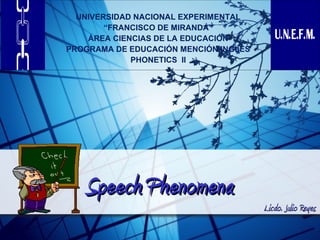
Speech phenomena
- 1. UNIVERSIDAD NACIONAL EXPERIMENTAL “FRANCISCO DE MIRANDA” ÁREA CIENCIAS DE LA EDUCACIÓN PROGRAMA DE EDUCACIÓN MENCIÓN INGLÉS PHONETICS II Speech Phenomena Licdo. Julio Reyes
- 3. Speech Phenomena In English, we have many natural speech phenomena (NSP) which, along with stress, give English its distinctive rhythm. We call these NSP because they are common in normal spoken English, colloquial, and especially in fast speech. Licdo. Julio Reyes
- 4. Speech Phenomena Linking “Linking” or “joining together” of sounds is what this term refers to. In general, we produce the phonemes that belong to the words we are using in a more or less continuous stream, and the listener recognizes them (or most of them) and receives the message. Linking takes place when the end of one word is joined on to the beginning of the following word. In English the best- known case of linking is the “linking r”: there are many words in English (e.g. ‘car’, ‘here’, ‘tyre’) For example: ‘The car is’ ðə kɑ_r iz " ‘Here are’ hIər ə Licdo. Julio Reyes
- 5. Types of Linking Consonant to consonant linking (CC) The final consonant in a word links with the consonant of the following word, if both consonants are similar. pressed daisies epidemic cholera apparent takeover Consonant to vowel linking (CV) If a word ends in a consonant and the next word begins with a vowel, the consonant links up with the following word. (Final consonants can also link with initial <w, h, y, r> of the following word, especially in faster speech.) weak eyes sweet oranges for admission Licdo. Julio Reyes
- 6. Types of Linking Vowel to vowel linking (VV) If a word ends in a vowel and the next word begins with a vowel (in faster speech, they may also link if the second word begins with <w, h, y, r>). to our home the Olympics high in the air thirty hours Licdo. Julio Reyes
- 7. Speech Phenomena Blending Blending (palatalization) Final <t, d, s, z> sounds blend with following <y> sounds when <y> begins a function word, creating new sounds. For example: Could you -- couldja Can’t you --can’tcha . press your – pressyur. as your -- azyur zy. Licdo. Julio Reyes
- 8. Speech Phenomena Elision - Deletion The nature of elision may be stated quite simply; under certain circumstances sounds disappear. That is, a phoneme may be realised as zero, or have zero realisation or be deleted. Elision is typical of rapid, casual speech. Licdo. Julio Reyes
- 9. Types H-deletion The <h> beginning a function word gets deleted within a sentence; often this deletion leads to linking. let her (sounds like letter) get him Cluster simplification A consonant cluster is a group of two or more consonants together. When a consonant cluster comes at the end of a word, the last consonant often gets cut off, specially if the combination is hard to pronounce quickly. This is more common in faster speech. just once [wAns] Ghost Busters months [mAns] just starting Licdo. Julio Reyes
- 11. Speech Phenomena Weakening Final consonant weakening Final <t, p, k> are not pronounced with a release of air if the next word begins with a consonant, or at the end of a phrase or sentence. just¬ because sap¬ sucker sick¬ leave Just¬ do it¬ !. Licdo. Julio Reyes
- 12. Weakening Medial t-weakening Oftentimes the <t> inside a word weakens and sounds something like a [d], especially before a vowel. This happens when the <t> comes after a stressed syllable and before an unstressed syllable. At the beginning of a stressed syllable, <t> is pronounced with full strength. This weakening also happens in phrases, for example, when a content word followed by a function word. letter, batter, hitter, bitter, better pattern, spotted, clutter, fertile, transporter, reporter, let her, let him, get him Licdo. Julio Reyes
- 13. Weakening Weak syllable reduction (iambic reduction) In many words with a stressed syllable followed by two weak (unstressed) syllables, the first weak syllable is reduced or deleted — pronounced extremely lightly and quickly, or not at all. interest [int’rest] probably [prob’bly] finally [fin’lly] also: conference, difference, histoy, etc. Licdo. Julio Reyes
- 14. Speech Phenomena Haplology Haplology is defined as the elimination of a syllable when two consecutive identical or similar syllables occur. The phenomenon was identified by American philologist Maurice Bloomfield in the 20th century. Linguists sometimes jokingly refer to the phenomenon as "haplogy" (subjecting the word "haplology“). For example: Library Pierced-ear earrings > pierced earrings Probably February Licdo. Julio Reyes
- 15. Speech Phenomena Coalescence - Asimilation Speech sounds rarely have clear-cut boundaries that mark them off from their neighbors. It sometimes happens that adjacent phonemes slide together (coalesce) so that they seem to happen simultaneously. An example is what is sometimes called yod- coalescence, where a sound preceding a j (“yod”) becomes palatalized: thus the “s” at the end of ‘this’ can merge with the “j” of ‘year’ (content word) to give a pronunciation ðiʃʃiə or ðiʃiə. Licdo. Julio Reyes
- 16. Speech Phenomena Geminate When two identical sounds are pronounced next to each other (e.g. the sequence of two n sounds in English ‘unknown’ _nnəυn) they are referred to as geminate. The problem with the notion of gemination is that there is often no way of discerning a physical boundary between the two paired sounds. Licdo. Julio Reyes
- 17. Speech Phenomena Metathesis From the Greek, "to transpose“. "The order of sounds can be changed”. Metathesis is what takes place when two sounds or syllables switch places in a word. This happens all the time in spoken language. Tax and Task are variant developments of a single form, with the [ks] represented by x metathesized in the second word to [sk]. . . . "The /sp-/-/ps-/ metathesis in English can occur in the onset of an unstressed syllable as in spaghetti--psketti.“ Nuclear pronounced as /nukular/ and asterisk pronounced as /asteriks/). Licdo. Julio Reyes